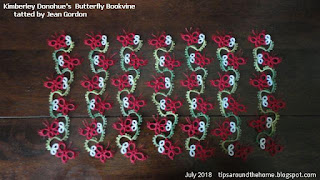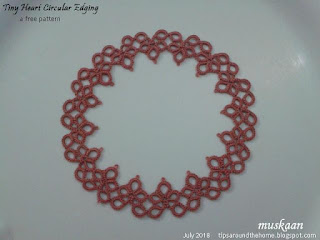There was a slight error in the diagram (I missed out a join).
Ninetta's videos and posts are
very clear and it was fairly easy to learn treble tatting.
The tds has a multiple of steps reminding me of crochet, padded ds and vapour picot. Was the resemblance to them actually there? Why was there the need to pull up 2 successive loops for the first part? Where did the ds disappear? These were some of the questions that plagued me.
I got the How easily enough, but the What and Why needed some minute dissection.
In order to
observe each step of the tds closely, I chose thick threads in contrasting colours and took pics of each step.
These pics visually tell the story of it’s construction, and also the
engineering genius of it’s originator!
Just to be clear at the outset,
this is how a crochet chain and treble look :
the crochet treble is clearly
different from this tatted treble stitch.
A single chain stitch, however, is
similar in both cases.
YET, the chain is similar to what we would do in a picot join - pull a loop up !
Treble Tatting
(tds)
Analysing
each step
1. I have started a chain with
4ds, 1vsp, 1ds.
2. Insert hook and pull up a loop through the vsp -
just as if we were making a picot join.
3. The loop is
visible.
4. Insert hook through
this loop now …
5. … and pull up another
loop (again like a picot join!).
Notice that this looks
like a crochet chain.
NOTE: Keep this stitch taut. If it is loose, it spoils the appearance later.
Although not yet
visible, this ds and chain form the 1st half stitch of a tds.
6. Insert the shuttle
through this loop from back to front.
This is the start of
the 2nd half.
Note the full ds at the base, with 2 'legs'
7. This is how it all looks after step 6.
9. The ball thread
tends to twist.
10. Repeat step 9 two
more times, so that there are now 3 twists in the ball thread.
UPDATE: see how this step can be worked like a Twisted picot !
11. CAUTION: While
making the wraps, the core thread tends to twist like in this pic.
Make sure that
all the twists are transferred to the ball thread (as in pic#10)
and the core remains free to
slide.
12. We now start
pulling the ball thread upwards to tension the wraps.
Though hazy, this is to
show how the core thread is held taut around the pinkie
and the ball thread is
pulled up.
13. The wraps are
closer now. Tug a bit more till all unwanted thread is pulled off.
Note the single thread (pink) around the core thread at the base.
This forms the 3rd leg of a tds.
14. 2nd half
complete.
Notice how the 1st
half also looks coiled and similar to the 2nd half? I think this is where her brilliance truly lies! The 1st half,
tends to ‘twist’ or lie on it’s side which has a coiled appearance!
However, at this point, the 2 threads (ball & shuttle) are quite apart, as you can see.
They need to be
brought together in order to continue….
15. Leave space that
is equal to the height of the tds. Then tat 1ds.
(This space acts as a picot for the next
stitch and the ds becomes part of the 2nd tds too. )
16. We now repeat
steps 2 to 15 to tat the next tds.
In above pic, 3tds have been made.
Notice that at the end of a single
tds or a row of tds,
there will always be a picot space followed by 1ds.
17. The crochet is pointing to
where the picot lies between 2 tds.
This is where we make joins when linking a
new element to it.
If desired, this can be made longer to give a decorative effect.
But when we need to join a tds to
a previous element/picot (as in this triangle motif), it requires a slightly
different approach. There are 2 ways to do it, both of which will be shared in
next post.
Also in the next post, I will share my way of making a 4-wrap tds.
A few more characteristics of the
treble ds :
- A tds is worked with one shuttle.
- Tds can be made on chains as well as rings, including mock rings
and thrown/floating rings.
- 1 tds has 2 half stitches just like a ds. But each half stitch is
constructed quite differently. They look visually similar, but are not
mirror images as in ds.
- A single treble comprises of : vsp, ds, 2 loops (chain), 3 wraps, vsp, ds, where the last ds becomes part of the next tds or element.
- Thus 1st half stitch of a tds comprises 1ds, 2loops ; and 2nd half comprises 3 wraps; both flanked by a vsp.
to be continued ...




















































